In a world full of adventure and boundless exploration, there’s nothing quite like the thrill of hopping on your trusty bicycle and embarking on a two-wheeled journey. But what happens when your key mysteriously vanishes, leaving you standing in front of your locked-up steed?
In such a case, you might get confused about how to unlock a bike lock without a key. Well, fear not, intrepid adventurer, because, in this guide, I will unveil six exciting methods to unlock a bike without a key.
From the ingenious to the daring, these unconventional techniques will test your resourcefulness and may just save the day when your two-wheeled companion is held captive by an unyielding lock.
So, gear up, brace yourself, and prepare to discover the secret art of bicycle lock liberation, because nothing can stand between you and the freedom of the open road!
What is a Bicycle Lock
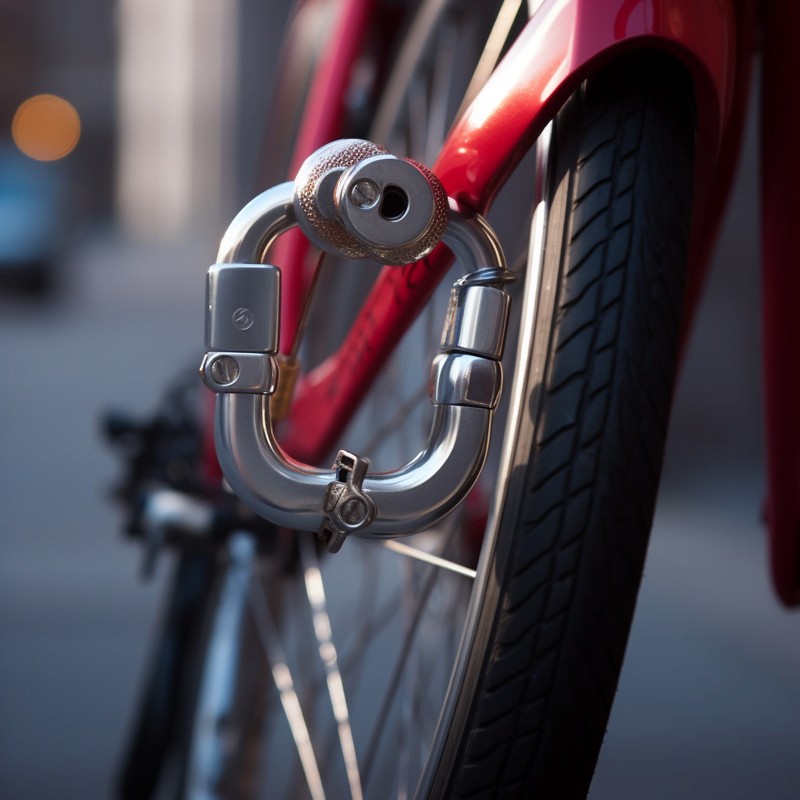
A bicycle lock serves as a security mechanism employed to discourage bicycle theft. It accomplishes this by either securing one of the wheels or attaching the bicycle to a stationary item such as a bike rack.
What Type of Lock is Installed on a Bike
There are several types of locks commonly used to secure bikes, each offering different levels of security and convenience. Here are some of the most prevalent types:
U-Lock
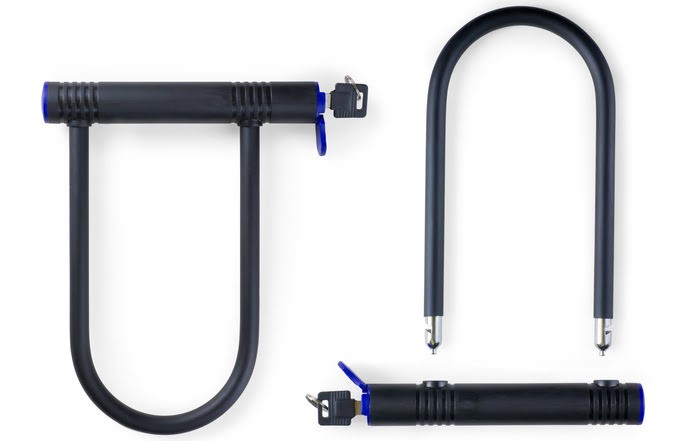
This popular lock features a rigid, U-shaped shackle made of hardened steel. It provides excellent security against cutting and leverage attacks and is often considered one of the most secure options.
Cable Lock
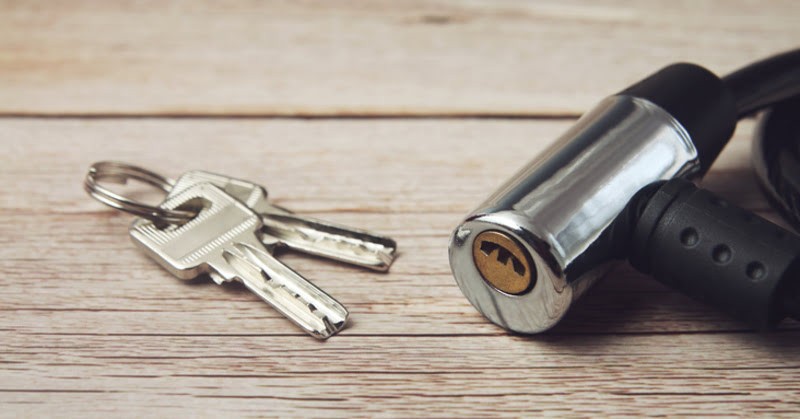
A cable lock consists of a flexible steel cable encased in a protective outer layer. While lighter and more portable than U-locks, they offer lower security levels and are more susceptible to cutting.
Chain Lock
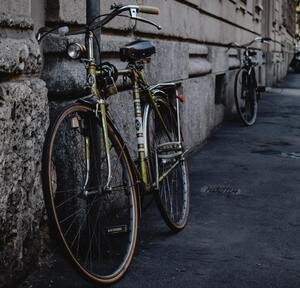
Chain locks employ a durable chain made of hardened steel links. They are often thicker and heavier than cable locks, providing higher security against cutting attempts.
Folding Lock
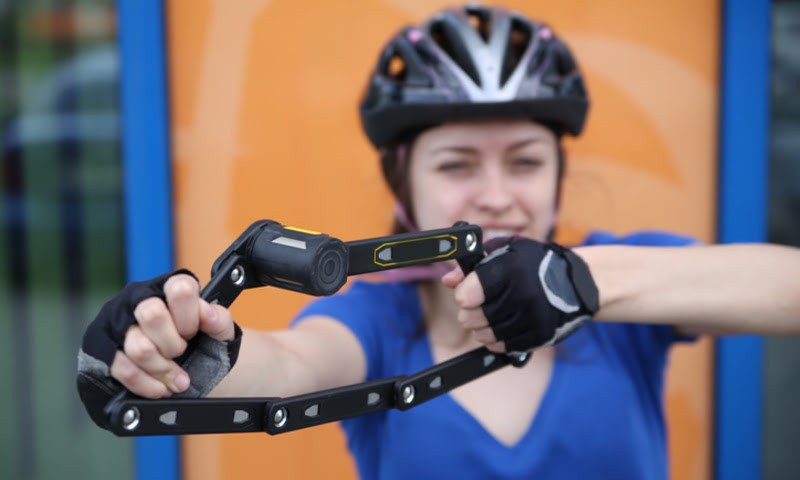
These locks feature multiple interconnected bars that can be folded or unfolded. They offer a good balance between security and portability, as they can be compactly folded when not in use.
Combination Lock
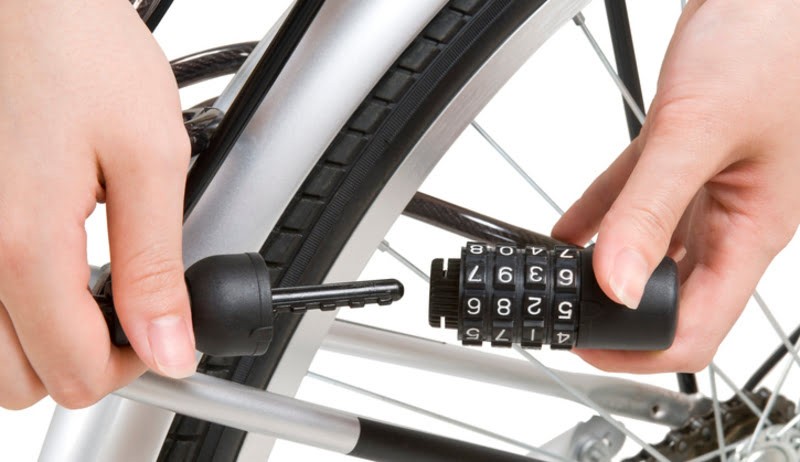
These locks utilize a series of digits or letters that must be aligned to unlock the mechanism. They eliminate the need for keys but can be vulnerable to guessing or manipulation.
Note: It’s important to assess the security needs of your bike and choose a lock that offers an appropriate level of protection based on the area and circumstances in which you’ll be leaving your bike unattended.
How to Unlock a Bike Lock Without a Key [Possible Ways]
Unlocking a bicycle lock without a key is not recommended unless you are the rightful owner of the bicycle or have proper authorization. Tampering with or bypassing someone else’s bicycle lock without permission is illegal and considered theft.
However, if you have lost the key to your own bicycle lock or forgotten the combination, you can try the following methods:
#1 Consider Lock Picking
Take into consideration the art of lock picking. This tried-and-true technique can come in handy when you find yourself faced with a bicycle lock but no key.
However, always remember that lock picking is not a simple task, as modern locks often incorporate intricate locking mechanisms that make them highly resistant to picking.
To successfully pick a lock, you will require several tools:
- A lock pick set
- A tension wrench
- Knowledge and skills in lock-picking
Keep in mind that easier-to-pick locks are usually cheaper, so if you know your lock falls into this category, there’s a chance you can unlock it without a key. However, be aware that there might be legal considerations in your area regarding lock picking, so it’s essential to conduct thorough research.
Now to begin picking your bicycle lock, insert the tension wrench into the keyhole (plug) and apply gentle pressure to the cylinder. Next, insert the picking tool and carefully search for the key pins.
Once you locate the first key pin, gradually lift it while maintaining tension with the wrench. Once the key pin surpasses the shear line, you will feel a slight click. This indicates that it’s time to move on to the next key pin.
Repeat this process until all the pins have been set in their proper positions. At this point, you should be able to rotate the lock open using the tension wrench. Congratulations if you succeed! If not, don’t worry; there are other methods to explore for opening locks without keys.
#2 Use a Plastic Pen (BIC/Biro Style Pen)
This technique is widely used to unlock a bicycle lock without a key, particularly for U-locks.
Step 1: Obtain the Pen and Remove the Ink Tube
To prevent any damage to the ink tube, it is highly advisable to remove it. Use only the empty plastic casing of the pen, avoiding the metal cap.
Step 2: Insert and Manipulate the Hollow Pen Tube
Once the ink tube and metal cap are removed, insert the hollow tube into the lock. Press it slowly and firmly as far as it can go while continuously wiggling the hollow pen tube for a reasonable amount of time before proceeding.
Another method of insertion involves applying firm pressure to the lock. However, I do not recommend this method as it may deform the plastic tube, rendering it useless afterward. Exercise caution during this step, as there is a possibility of the pen tube snapping inside the lock if excessive force is applied.
Step 3: Continue Wiggling the Pen until the Lock Disengages
Keep the pen wiggling while applying counterclockwise pressure. The objective is to engage the pins within the plastic at the end of the pen case.
After a few minutes of wiggling and pushing, the bicycle lock should open. There is no need for aggressive force; this method relies on patience and careful manipulation. Soon enough, you will be able to use your bike again.
#3 Use a Shim to Open the Lock without Keys
If you didn’t have success with the BIC pen trick, using a shim is another effective approach to remove a bicycle lock without a key, particularly for cheaper bike locks.
So, what exactly is a shim? A shim is a thin piece of rigid metal or plastic often found in cans. It is placed between the shackle and the locking bolt, effectively displacing the bolt from its intended position.
One limitation of this method is that it may not work on more expensive bicycle locks or combination locks, as they are designed with features to resist basic picking methods like shimming. However, if the pen method didn’t work, this technique is certainly worth a try.
Step 1: Wear Protective Gloves
Before proceeding with the steps in this method, it is highly recommended to wear protective gloves to safeguard your hands from cuts, as you will be working with sharp metal from a soda can.
Step 2: Obtain an Empty Soda Can
The next step is to find an empty soda can and use it to create the shim. Alternatively, pre-made shims are available at specialized stores. However, it’s always advantageous to be resourceful and avoid unnecessary expenses.
Cut a rectangular piece from the soda can and hollow out the center to create an M-shaped strip. Fold the piece until it resembles a flat cigar. Then, bend the shim in the middle to form an L-shape. Exercise extreme caution during this process. The pointed tip of the shim will be inserted into the shackle of the bike lock’s body.
Step 3: Insert the Shim into the Lock
Place the shim between the bicycle lock and the shackle. Carefully insert it into the shackle hole and attempt to override the padlock. For double-bolted locks, you may need to use two shims. Using two shims is also recommended for higher-quality locks.
Step 4: Depress the Bike Lock
The next step is to depress the bicycle lock, causing its locking mechanism to retract. If done correctly, this action will prevent the bolt from securely gripping the shackle. By picking the bicycle lock in this manner, all locks should open immediately.
#4 Try Decoding the Code
Unlocking a combination lock on your bike without the code can be challenging. However, there are methods that can assist you in determining the correct combination. While decoding the lock, remember to maintain tension by keeping the shackle or cable taut.
Here’s a guide on how to unlock a bike lock without a key by decoding the combination code:
Step 1: Listen for the Tumblers’ Clicks
Most combination locks have 4 to 6 tumblers. Pay close attention and try to identify the clicks as you turn the dial. By listening carefully, you might be able to guess the combination through trial and error.
Step 2: Feel for Vibrations
Another approach is to feel for subtle vibrations while turning the dial. If you detect any slight variations in vibration, they could indicate the numbers that form the combination.
Step 3: Determine the Possible Number Combinations
Combination locks typically consist of 3-4 numbers. Grab a pen and paper and jot down all the possible combinations of 3-4 numbers ranging from 0-9.
Step 4: Record the Dial’s, Directional Turns
To narrow down the combinations, note the number of times you turn the dial clockwise and counterclockwise before the bike lock opens.
Step 5: Test Each Written Combination until you find the correct one
Keep track of the combinations you’ve already tried and systematically go through the list until you discover the right combination.
Step 6: Change the Combination Immediately after Unlocking the Bicycle Lock
To ensure the security of your bike, it’s advisable to change the combination once you’ve successfully unlocked the lock without a key. This prevents others from using the same combination to open it.
By following these steps, you should be able to unlock a bicycle lock without a key using a combination lock. It may require time and patience, but eventually, you’ll succeed in freeing your bike.
#5 Go to a Locksmith
If you have already attempted the aforementioned steps and have lost the keys to your bike, it might be advisable to seek assistance from a local locksmith. Locksmiths possess extensive knowledge of locking systems and can help you unlock your bicycle lock without its keys.
Opting for a locksmith’s services can be beneficial for various reasons. Firstly, you may want to avoid damaging your bicycle lock or being wrongfully accused of theft, both of which are valid concerns.
Although this method tends to be the most expensive among the suggested approaches, it also carries the highest probability of success.
A locksmith may need to cut off your bicycle lock if necessary, but at least you will have your bike back. Now is the time to consider acquiring a high-quality replacement lock. A locksmith possesses the essential tools to remove nearly any type of lock, saving you both time and preserving your dignity.
To ensure you receive the best possible price, it is recommended to request quotes from different locksmiths.
#6 Contact a Local Bike Shop
Certain bike shops possess the necessary tools to unlock a bicycle lock without keys. They can assist you by cutting off the lock, typically charging a nominal fee for their service. If your bicycle lock is not of high value, this approach may be the most suitable option.
It is recommended to contact various bike shops in your vicinity and inquire about their ability to assist you.
How to Unlock a Bike Lock with Force
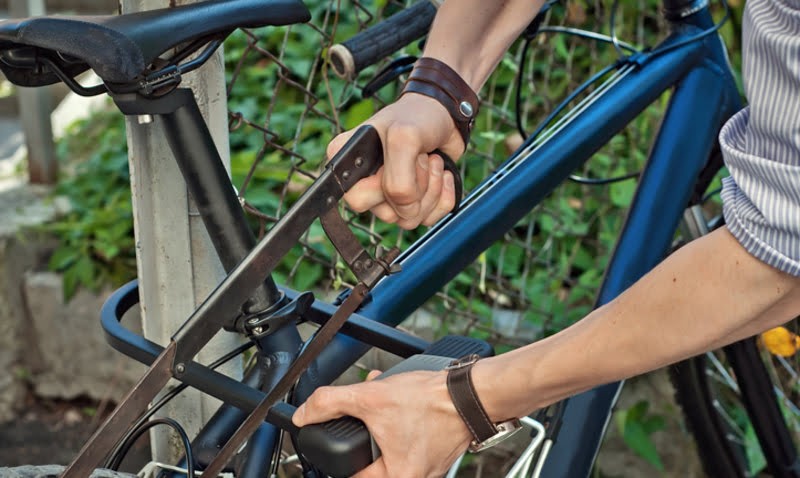
Unlocking a bicycle lock with force is not recommended and is likely to cause damage to the lock or the bicycle itself. It may also be illegal and considered theft if you are attempting to unlock someone else’s bicycle lock without proper authorization.
Nevertheless, I acknowledge that there may be instances where alternative methods prove ineffective, making this process a necessity. Hence, let us explore various methods or approaches that can be attempted in such circumstances.
#1 Breaking a U-lock with a Hammer and Air Spray
Acquire a can of compressed air spray: U-locks are highly resistant to forceful methods such as hammering, but their strength can be compromised when exposed to extreme cold.
Purchase compressed or canned air from home improvement stores or online, as these products contain difluoroethane, a compressed chemical that can cool the lock to temperatures around -13 degrees F (-25 degrees C).
Position the U-lock
If the U-lock is secured but not attached to any object, breaking it will be relatively straightforward. However, if the U-lock is fastened around a bicycle or a door handle, it will require a bit more effort to open, though it can still be accomplished. Orient the U-lock so that the bar lies flat on the ground or is pressed against a stable surface such as a door or a bike rack bar.
Direct the Canned Air Spray at the U-lock’s Keyhole
Position the can of air spray about a foot away from the keyhole. Depress the trigger to release the compressed air and direct it towards the keyhole.
Spray for Approximately 30 seconds
Continuously spray the compressed air for approximately 30 seconds. Observe the bar turning white as the chemical interacts with the surface of the U-lock, chilling it. Ensure that your spraying is focused primarily on the keyhole, where you will concentrate your hammering.
Commence Hammering on the Keyhole
After around 30 seconds, the U-lock’s bar should have cooled sufficiently and become brittle. Use your non-dominant hand to secure the U-lock’s loop against the ground or the surface it is positioned against. Take the hammer in your dominant hand and begin hammering the keyhole area.
Keep your fingers away from the impact zone and strive to maintain the stability and position of the U-lock while hammering. Do not be concerned if you observe a mist of white powder resulting from the hammering process.
Continue Hammering until the U-lock Breaks
Persist in hammering the keyhole section of the U-lock. It may take approximately 30 seconds or longer until a fragment breaks off from the bar, making the subsequent breaking easier.
Concentrate your hammering on the broken area of the lock. Additional sections will detach until the bar completely breaks away from one or both sides of the U. Exercise patience, as it may require several minutes of hammering to successfully break the U-lock. Properly dispose of the remaining pieces of the lock once you have finished.
#2 Cutting the Bicycle Lock with an Angle Grinder

Ensure Safety Measures are in Place
An angle grinder is a powerful tool for breaking U-locks and other types of locks. To handle it responsibly, it’s crucial to take proper safety precautions.
Familiarize yourself with the angle grinder and feel comfortable using it before attempting to break your U-lock. Wear work gloves to protect your hands and goggles to shield your eyes from any debris.
Avoid wearing loose clothing or jewelry while operating the angle grinder. Verify that you are using the appropriate-sized disc for the grinder and that it can reach maximum speeds. If the U-lock is not attached to anything, secure it in a vice clamped to a table.
If the lock is fastened around a bicycle, stabilize it so that it remains in a fixed position when pressure is applied.
Activate and Position the Angle Grinder
Hold the angle grinder with both hands at an angle of 15-30 degrees. Position the angle grinder a few inches away from the U-lock and turn it on.
Cut through the U-lock with the Angle Grinder
Use both hands to hold the angle grinder and gradually bring the blade into contact with one of the U-shaped sides of the lock. Do not be alarmed by sparks generated during cutting, as they pose no harm even if they make contact. Maintain the blade against the side of the U-lock until it cuts through.
The cutting process can take anywhere from 15 seconds to a few minutes. Exercise caution and proceed slowly and deliberately when using the angle grinder. Avoid applying excessive force or pushing with the grinder. Simply hold the blade against the lock and allow it to chip away.
Applying force while cutting may cause the grinder to cut through the U-lock and continue cutting into whatever is behind it.
Perform another Cut a few inches from the First Cut
If you need to remove the U-lock from your bike or a door handle, you will need to create an additional cut to dislodge it. Employ the same method used for the first cut, this time cutting through a section a few inches away from the initial cut. Stop cutting once the second cut is complete.
Turn off the Angle Grinder and Remove the U-lock
Once you have finished using the angle grinder, switch it off. It’s important for safety reasons to promptly turn off the grinder after completing the task. After making the second cut, a portion of the U-lock should have detached, creating a gap in the lock. Remove the U-lock, store your angle grinder, and dispose of the remaining parts of the lock appropriately.
#3 Cut the Bicycle Lock using Bolt Cutters
If all other methods have been unsuccessful, as a last resort, you can use bolt cutters to cut through a bicycle lock and unlock it without a key. However, it’s important to note that using bolt cutters may cause permanent damage to the lock, rendering it unusable.
Here’s a step-by-step guide on how to cut a bicycle lock with bolt cutters:
Step 1: Determine the appropriate size of bolt cutters needed for your lock. If the lock is thick, you will require a larger pair of bolt cutters. Test the size by placing the cutters around the shackle of the lock and squeezing gently.
Step 2: Prior to using the bolt cutters, ensure you put on safety glasses to protect your eyes from any flying metal pieces.
Step 3: Position the bolt cutters around the shackle of the lock, making sure to grip it firmly on both sides of the cutters.
Step 4: Apply steady pressure and squeeze the bolt cutters until you hear a snapping sound, indicating that the lock has been cut through successfully.
Step 5: Carefully remove the broken pieces of the lock from your bike, and you are now free to proceed.
Please exercise caution and prioritize your safety while using bolt cutters, as they are sharp and powerful tools.
List of Best Bicycle Locks in the Market Today
U-Locks
1. Kryptonite New-U New York Lock
Key Specifications
Weight – 4 lb.
Frame Mount – Yes
Locking Mechanism – Disc detainer
The Kryptonite New-U New York Lock can be summarized by its fine print: If your bike is stolen due to the compromise of this lock in a city where bike theft is prevalent, the company will replace your bike (up to $4,000).
This U-lock boasts a 16mm hardened steel shackle and incorporates a pass-through crossbar design, effectively thwarting twisting attacks and requiring thieves to make two cuts to breach the lock. In addition to its primary function, the four-pound lock also serves as an effective mallet, confirmed through personal experience.
The included mounting bracket employs a nylon strap for attachment to the frame, eliminating the need to go through the bottle bosses. This design offers greater flexibility in terms of mounting positions.
However, user reviews are mixed regarding the long-term effectiveness of the friction-based mount, as it relies on friction to keep the lock in place. One resourceful Amazon reviewer took matters into their own hands by using additional hardware to secure the mount to the bottle bosses, which may provide a sturdier alternative to the friction mount.
Pros
- High security
- Relatively lightweight
Cons
- Flimsy mounting bracket
2. Hiplok DX Wearable Maximum Security
Key Specifications
Weight – 2.4 lb.
Frame Mount – No
Locking Mechanism – Pin Tumbler
For years, urban cyclists have been managing by squeezing mini U-locks into their back pockets or tucking them beneath their belts, which is functional but far from comfortable. Recognizing this issue, Hiplok introduced an innovative redesign of the U-lock that incorporates a crucial addition: a clip.
This clip allows the lock to slide onto your waistband, providing a more convenient riding experience, as long as you have a waistband that fits snugly enough. The remainder of the lock is impressively robust, featuring a 14mm shackle that secures on both sides of the crossbar.
In the test, the shackle proved to be highly resistant, as it quickly defeated the blade of my hacksaw. However, when faced with a five-inch cordless angle grinder, the shackle succumbed within approximately 30 seconds.
This is a typical timeframe for cutting through a hardened steel shackle, and it should be noted that two cuts are necessary to bypass this lock.
Pros
- Sleek design
- Clips to waistband
Cons
- Small size
Folding Locks
1. Altor APEX Folding Bike Lock
Key Specifications
Weight – 2.4 lb.
Frame Mount – Yes
Locking Mechanism – Disc detainer
The Apex folding lock by Altor is a sophisticated device that exudes a premium quality commensurate with its price. Weighing in at 2.4 pounds, it is relatively lightweight compared to other folding locks.
Its bottle mount proved to be reliable during testing, as the Apex remained securely in place without any rattling while pedaling. When unfolded, it provides sufficient size to secure both your frame and either the front or rear wheel.
The lock’s construction incorporates hardened steel, which offers formidable resistance against manual tools. Previous versions, such as the 560G, experienced hinge drilling vulnerabilities, but the Apex addresses this by featuring hardened steel joint caps that safeguard the rivets from drilling attacks.
Pros
- Great price
- Easy to store
- Won’t rattle in movement
2. RockyMounts Hendrix Compact Folding Bicycle Lock
Key Specifications
Weight – 1.6 lb.
Frame Mount – Yes
Locking Mechanism – Disc detainer
The Hendrix is an exceptionally compact non-cable lock, making it one of the smallest options available. To enhance its portability, RockyMounts provides a holder that can be mounted on your frame’s bottle bosses.
The lock consists of 5mm steel links, which pose a challenge for cutting tools, and it also incorporates hardened pins designed to resist power drills. However, it’s important to note that this lock is not considered highly secure according to RockyMounts’ own security scale, which rates it a 7 out of 10.
Nevertheless, if you’re seeking a lock with medium security that can conveniently fit into a jersey pocket, the Hendrix may be the optimal choice.
Pros
- Travel-ready design
- Very small and lightweight
Cons
- 27-inch folding circumference limits lock-up options
Chain Locks
1. Hiplok Gold Wearable Chain Bicycle Lock
Key Specifications
Weight – 5.3 lb.
Frame Mount – No
Locking Mechanism – Pin Tumbler
The Hiplok Gold is a unique chain lock designed to be worn rather than simply attached to your waist, which could be hazardous in case of a crash. Instead, it employs a patented nylon clip and hook-and-loop waist adjuster that fastens around your torso.
This lock boasts a robust 10mm-thick hardened steel chain and a 12mm hardened steel shackle, both enclosed in a protective nylon shell. The chain’s sleeve can be removed and washed, and its reflective coating enhances nighttime visibility.
During testing, I realized that the adjustable belt is not suitable for riders with waists smaller than approximately 30 inches (this information is even provided on Hiplok’s website).
In fact, individuals with 32-inch waists might experience some slippage. However, for shorter commutes, I found it to be convenient, and it offers a high level of security.
Pros
- Washable sleeve
- Wearable design for convenient carrying
Cons
- Too big for waist sizes smaller than 30 inches
Lightweight Locks
1. OTTOLOCK Combination Bike Lock
Key Specifications
Weight – 0.5 lb.
Frame Mount – Optional
Locking Mechanism – a 3-digit combination
The Ottolock Cinch provides reliable protection for short visits to the store (not recommended for extended periods or high-risk locations). Weighing only 0.5 pounds, this lock utilizes a combination of Kevlar and steel bands to deter cutting attempts.
It can be easily coiled up into a compact 3-inch-diameter package, conveniently stored beneath your saddle rails. While it doesn’t substitute a traditional U-lock, it surpasses cables in terms of size and durability, offering a practical upgrade.
Additionally, the company offers a frame or seat post mount for $25 to facilitate easy attachment.
Pros
- Keyless entry
- Bright, colorful
- Attractive design
Cons
- Can be cut with hand tools
2. BELL QuickZip Zip-Tie Lock
Key Specifications
Weight – 0.45 lb.
Frame Mount – No
Locking Mechanism – the 3-digit combination
You can find these Bell locks, which resemble zip ties, at Target and on Amazon, and you can purchase two for a lower price than Hiplok’s Z Lok. These lightweight locks are nearly identical in terms of weight and size, with the Bell lock being approximately 2 inches long. Both locks feature a three-digit combination mechanism.
I noticed that the number wheels on the Hiplok lock rotated more smoothly compared to the Bell lock, but this was the only noticeable distinction. Moreover, the locks have the same cores, consisting of a thin metal band. I tested both locks by attempting to cut them with household scissors, and they both withstood such attempts.
However, when I used a decent pair of wire cutters or metal shears, both locks failed immediately.
Pros
- Excellent value
- Super lightweight and packable
Cons
- Easily cut with shears or snips
Summary — How to Unlock a Bike Lock Without a Key
Knowing how to unlock a bike lock without a key can be a valuable skill for any cyclist. Whether you’ve misplaced your key or find yourself in an emergency situation, these methods provide alternative solutions to regain access to your locked bike.
Remember to always use these techniques responsibly and ethically, and never attempt to unlock a bicycle lock that doesn’t belong to you without proper authorization. With the right knowledge and a bit of practice, you can overcome a locked bike situation and get back on the road in no time. Happy cycling!
Please share your thoughts and feedback on the article in the comments section. Please like, share, and follow our Facebook Page, and keep visiting our website for more guides like this.
How to Unlock a Bike Lock Without a Key — Frequently Asked Questions
Is it easy to open a bicycle lock without the key?
The ease of opening a bicycle lock without the key varies depending on the type of lock used. U-locks pose a greater challenge as they typically require lock picking, which can be difficult without the appropriate tools.
Chain locks can often be bypassed using shimming or picking techniques, making them somewhat easier to open. In comparison, cable locks are the simplest to unlock as they can be easily cut with bolt cutters or manipulated by trying different combinations.
Can a locksmith make a duplicate key for a lock without the original key?
Certainly, a locksmith has the ability to produce a duplicate key for a bicycle lock even without the original key by using a technique called impressions. This involves shaping a blank key by carefully studying the lock and creating a matching key based on the impressions left by the lock’s internal mechanisms.
Can I use a universal key or a master key to unlock a bicycle lock?
Universal keys or master keys are generally not available for bicycle locks. Bicycle locks are designed to provide a certain level of security, and using a universal or master key would defeat their purpose. Each lock typically has its own unique key or combination.
Related:
